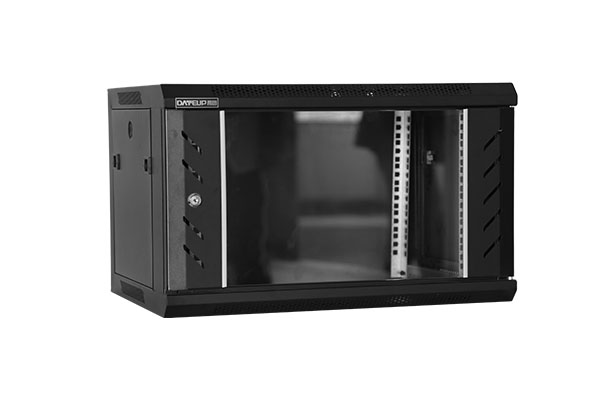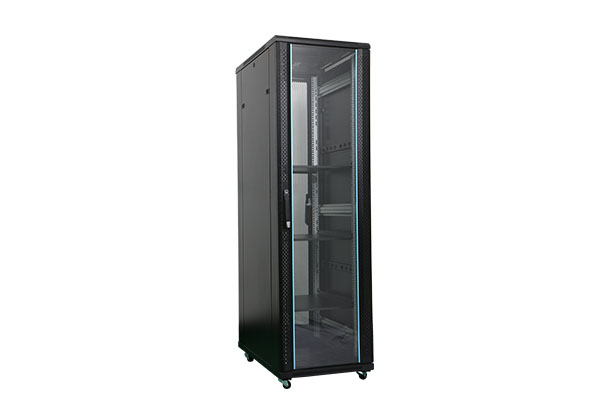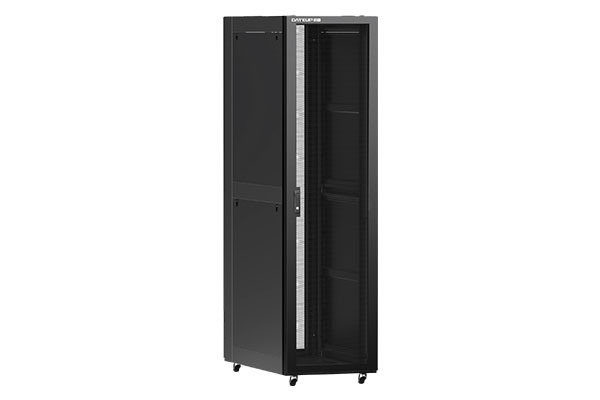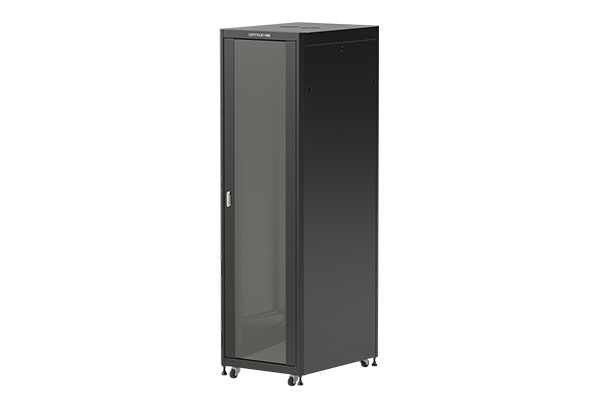Network cabinet knowledge is revealed, how much do you know?
Release Time : 2025-03-12
Comprehensive analysis of network cabinets
Network cabinets play a vital role in modern information technology infrastructure. It is not only a key carrier for the storage and protection of network equipment, but also provides important support for heat dissipation, wiring and management. This article will explore the basic concepts, types, size standards and selection techniques of network cabinets in depth to help readers better understand and apply this important IT infrastructure component.

1. Basic concepts of network cabinets
Network cabinets are special cabinets for storing network equipment. Their main function is to provide physical support and protection for network equipment such as routers, switches, and patch panels. Network cabinets are usually made of metal materials, have good mechanical strength and electromagnetic shielding performance, and can effectively protect internal equipment from the influence of the external environment. In addition, network cabinets also provide convenient conditions for the wiring, heat dissipation and maintenance of equipment.
2. Main types of network cabinets
Depending on different needs and application scenarios, network cabinets can be divided into many types, including:
1. Server cabinets: mainly used to store server equipment, usually with higher load capacity and heat dissipation performance
2. Network cabinet: specially designed for storing network equipment, such as switches, routers, etc., with optimized wiring system and heat dissipation design.
3. Wall-mounted cabinet: suitable for environments with limited space, can be fixed on the wall to save floor space.
4. Intelligent protective outdoor cabinet: designed for outdoor environments, with high waterproof, dustproof and weather-resistant performance.
5. Standard cabinet: conforms to industry standard size (such as 19 inches), which is convenient for unified management and installation of equipment.

3. Size standard of network cabinet
Choosing the right network cabinet size is an important part of computer room design and equipment layout. Here are some basic knowledge about network cabinet size:

1. Width size: The standard network cabinet width is usually 600mm or 800mm, but there are other unconventional sizes available, such as 1000mm or 1200mm. When choosing the width, you need to consider the spatial layout of the computer room and the number and size of the equipment.
2. Depth: The depth of common network cabinets ranges from 600mm to 1000mm, and can be selected according to the depth of the equipment, the need for wiring and maintenance space. Generally speaking, cabinets with shallower depths are more suitable for places with limited space, while cabinets with greater depths are suitable for environments that require more wiring and maintenance space.
3. Height: The standard height of a network cabinet is usually 42U (about 73.5 inches), which is the most common size. Of course, there are also network cabinets with other heights to choose from, such as 45U, 47U, etc. When choosing the height of the cabinet, you need to consider the floor height of the computer room and the height of the equipment to ensure that there is enough space when the equipment is installed and it is easy to maintain and manage.
4. How to choose a suitable network cabinet
Choosing a suitable network cabinet requires considering multiple factors, including the spatial layout of the computer room, the number and size of equipment, heat dissipation requirements, wiring methods, etc. Here are some specific selection tips:
1. Consider the spatial layout of the computer room: Before choosing a network cabinet, you must first consider the spatial layout and remaining space of the computer room. Ensure that the size and shape of the cabinet can adapt to the environment of the computer room and will not hinder the installation and maintenance of other equipment.
2. Determine the number and size of equipment: Choose the appropriate cabinet model according to the number and size of network equipment to be stored. If there are more devices or the size is larger, you can choose a cabinet with a larger capacity; if there are fewer devices or the size is smaller, you can choose a cabinet with a smaller capacity to save space.
3. Pay attention to heat dissipation needs: Network equipment will generate a lot of heat during operation, so it is necessary to ensure that the cabinet has good heat dissipation performance. You can choose a cabinet with a fan or vents to improve the heat dissipation effect; at the same time, avoid placing devices with high heat generation in one cabinet to prevent overheating damage.
4. Consider the wiring method: Reasonable wiring can effectively reduce signal interference and failure rate. When choosing a network cabinet, you can consider using the upper or lower wiring method, and reserve enough wiring space and interface positions according to actual needs.
5. Choose reliable brands and suppliers: Choosing well-known brands and high-quality suppliers can ensure the quality and service guarantee of network cabinets. You can refer to the popular brand rankings and user reviews on the market to make a wise choice.
Choosing the right network cabinet is crucial to ensuring the stable operation and long service life of network equipment. Understanding the types, size standards and selection tips of network cabinets can help us better meet actual application needs and improve work efficiency.
Network cabinets play a vital role in modern information technology infrastructure. It is not only a key carrier for the storage and protection of network equipment, but also provides important support for heat dissipation, wiring and management. This article will explore the basic concepts, types, size standards and selection techniques of network cabinets in depth to help readers better understand and apply this important IT infrastructure component.

1. Basic concepts of network cabinets
Network cabinets are special cabinets for storing network equipment. Their main function is to provide physical support and protection for network equipment such as routers, switches, and patch panels. Network cabinets are usually made of metal materials, have good mechanical strength and electromagnetic shielding performance, and can effectively protect internal equipment from the influence of the external environment. In addition, network cabinets also provide convenient conditions for the wiring, heat dissipation and maintenance of equipment.
2. Main types of network cabinets
Depending on different needs and application scenarios, network cabinets can be divided into many types, including:
1. Server cabinets: mainly used to store server equipment, usually with higher load capacity and heat dissipation performance
2. Network cabinet: specially designed for storing network equipment, such as switches, routers, etc., with optimized wiring system and heat dissipation design.
3. Wall-mounted cabinet: suitable for environments with limited space, can be fixed on the wall to save floor space.
4. Intelligent protective outdoor cabinet: designed for outdoor environments, with high waterproof, dustproof and weather-resistant performance.
5. Standard cabinet: conforms to industry standard size (such as 19 inches), which is convenient for unified management and installation of equipment.

3. Size standard of network cabinet
Choosing the right network cabinet size is an important part of computer room design and equipment layout. Here are some basic knowledge about network cabinet size:

1. Width size: The standard network cabinet width is usually 600mm or 800mm, but there are other unconventional sizes available, such as 1000mm or 1200mm. When choosing the width, you need to consider the spatial layout of the computer room and the number and size of the equipment.
2. Depth: The depth of common network cabinets ranges from 600mm to 1000mm, and can be selected according to the depth of the equipment, the need for wiring and maintenance space. Generally speaking, cabinets with shallower depths are more suitable for places with limited space, while cabinets with greater depths are suitable for environments that require more wiring and maintenance space.
3. Height: The standard height of a network cabinet is usually 42U (about 73.5 inches), which is the most common size. Of course, there are also network cabinets with other heights to choose from, such as 45U, 47U, etc. When choosing the height of the cabinet, you need to consider the floor height of the computer room and the height of the equipment to ensure that there is enough space when the equipment is installed and it is easy to maintain and manage.
4. How to choose a suitable network cabinet
Choosing a suitable network cabinet requires considering multiple factors, including the spatial layout of the computer room, the number and size of equipment, heat dissipation requirements, wiring methods, etc. Here are some specific selection tips:
1. Consider the spatial layout of the computer room: Before choosing a network cabinet, you must first consider the spatial layout and remaining space of the computer room. Ensure that the size and shape of the cabinet can adapt to the environment of the computer room and will not hinder the installation and maintenance of other equipment.
2. Determine the number and size of equipment: Choose the appropriate cabinet model according to the number and size of network equipment to be stored. If there are more devices or the size is larger, you can choose a cabinet with a larger capacity; if there are fewer devices or the size is smaller, you can choose a cabinet with a smaller capacity to save space.
3. Pay attention to heat dissipation needs: Network equipment will generate a lot of heat during operation, so it is necessary to ensure that the cabinet has good heat dissipation performance. You can choose a cabinet with a fan or vents to improve the heat dissipation effect; at the same time, avoid placing devices with high heat generation in one cabinet to prevent overheating damage.
4. Consider the wiring method: Reasonable wiring can effectively reduce signal interference and failure rate. When choosing a network cabinet, you can consider using the upper or lower wiring method, and reserve enough wiring space and interface positions according to actual needs.
5. Choose reliable brands and suppliers: Choosing well-known brands and high-quality suppliers can ensure the quality and service guarantee of network cabinets. You can refer to the popular brand rankings and user reviews on the market to make a wise choice.
Choosing the right network cabinet is crucial to ensuring the stable operation and long service life of network equipment. Understanding the types, size standards and selection tips of network cabinets can help us better meet actual application needs and improve work efficiency.







